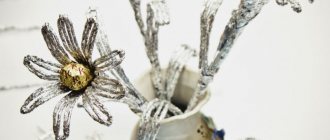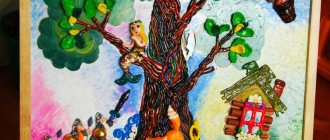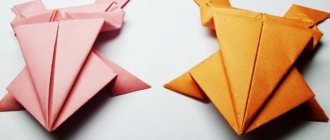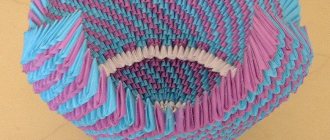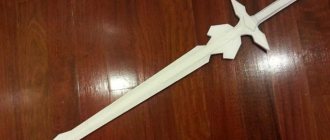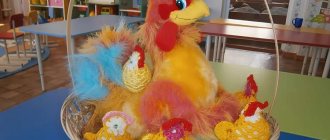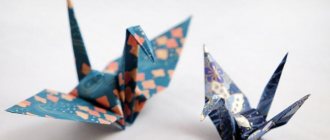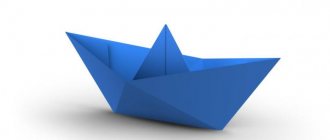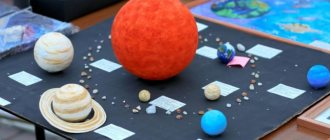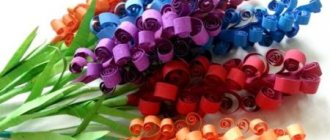For many peoples, the white dove is a recognized symbol of peace. An origami figurine of this bird is usually complemented with an olive branch, which can be made from thick paper or natural materials. The flying dove is also associated with love, hope and spiritual aspirations. His images often adorn Christmas cards and garlands as a reminder of the story of Noah's Ark. There are several popular models using the origami technique, all of them are distinguished by their simplicity and effective design.
What does the Dove of Peace symbolize?
Since ancient times, the dove has been considered a symbol of truce, and even earlier it was called a symbol of fertility.
In the countries of the East, gulki were sacred birds, because they are messengers of God. This concept of this bird was also traced in Christianity. In later times, doves became carrier pigeons; their arrival meant that some event had happened.
A handmade product in the shape of a bird will decorate any occasion: birthday, wedding or party, and will also be a special detail in your interior. You can place the figurine on a window, fireplace or attach it to the wall.
Paper dove of peace
Traditionally, the bird is made from white paper. However, there are no clear rules on this matter. A dove of peace made from origami paper is a simple craft if you follow the step-by-step instructions:
- Take a square piece of paper and fold it in half diagonally.
- Fold the triangle in half again and unfold to mark a line.
- Fold the bottom corners up toward the center line.
- Fold the loose ends down in the middle and straighten them to mark the lines.
- Fold the side corners towards the middle.
- Unfold them and fold them inside the workpiece.
- Fold the workpiece in half into a mountain. Place the long side to the left.
- Bend the top part diagonally to the left.
- Repeat on the other side.
- Fold the wing diagonally.
- Repeat on the other side.
- Fold diagonally again.
- Fold the tail along the resulting lines.
- Unfold it and fold it inside the workpiece.
- Form a beak.
- The dove is ready.
Paper birds are often used in room decoration. To create them, involve children to help, because origami develops motor skills, spatial thinking, and discipline.
Video tutorial:
What kind of paper is needed
Paper is the main material when making figurines. The result will depend on her choice. The simplest and most reliable option is regular office paper. If you want to diversify the appearance, you can use colored double-sided cardboard or cardboard.
If the craft is formed using several techniques, it may come in handy as additional corrugated paper napkins or even toilet paper. This type of cellulose raw material is softer and lighter.
Selection of materials
Of course, if you need a simple craft, the production time of which will not exceed 5 minutes, you can easily use regular A4 paper, which is the most common.
However, if you are aiming for higher quality and more labor-intensive work, office paper will not be suitable. The thing is that it is very thin. When exposed to moisture, it can become wavy, and after drying, water stains may remain on it. As a result, the appearance of the product will be spoiled, and the design will most likely be partially broken.
The best option is to use whatman paper. It is almost 4 times thicker than regular office paper, and much stronger. Moreover, a couple of drops of water will not leave a trace on it after drying.
Another good option is cardboard. It can be completely different in density, you can choose exactly the one you need. Another advantage of cardboard is that it is matte. This will add realism to the craft, since the feathers of pigeons are also matte in color.
Watercolor paper is used less frequently, due to the high prevalence of the previous options. You can purchase it in special stationery stores.
Particular attention should be paid to decorations.
There are almost no restrictions here. The only nuance is the fact that it is necessary to be guided by the density and strength of the material from which the base is made. And based on this data, select jewelry. This could be various rhinestones and sparkles, corrugated cardboard, perhaps even decorative feathers.
And of course, during the manufacturing process you will need scissors, a pencil, an eraser and glue.
It is recommended to use PVA; with it there is less risk of saturating the material, thus leaving marks on the surface.
Sheet and its folding
The meaning of folding is to mark a line or fold. To mark a line means to bring the edges of the sheet to the folding line and fold again. When folding, a sense of symmetry, patience and accuracy are important.
Normal folding involves creating another shape, but sometimes this shape has to be turned inside out. The closer you get to the end, the more difficult it is to make origami from paper. The pigeon according to the scheme for beginners requires no less “respect” than according to the video for masters.
A large amount of folding means a more labor-intensive process. This point should be kept in mind when getting acquainted with any option for making origami doves.
Knowledge and skills
Origami is an ancient art that has thoroughly entered everyday life in the last century. For many adults it has become the meaning of life. It gave many children knowledge, imagination, and the ability to creatively solve various problems.
A childhood hobby of folding origami doves out of paper later turns out to be a useful skill for solving a completely different problem. For example, fold a gift card or offer the company management an option for the design of a logo, the style of business correspondence, or a product packaging scheme.
Today everyone understands that producing a product or offering a service is extremely little. Packaging a product or presenting an offer beautifully is very important.
Knowledge and skills in origami can be applied not only in reality, but also in virtuality, for example, to create stylish, fold-out websites that not only present information, but pack/unpack it using semantic blocks.
It is very important for a child’s mental development to use origami. This is not such a complex technique, but it is an excellent opportunity to develop mental abilities, cultivate perseverance and give the opportunity to work on solving completely different problems in the distant future.
Good mental practice in childhood is an excellent foundation for future learning and work.
Preparing a Sheet of Paper
Any size square sheet can easily be turned into a dove, but a larger square is easier to fold. The thickness of the paper matters: the higher the density, the more difficult it will be to work. It is best to start with a standard sheet of A4 size and a density of 80 g/m3. It's a comfortable size and good density.
By applying the larger side to the smaller one, we get a triangle. Having cut off the excess with scissors, we get a square on which a line is already marked for starting work.
The easiest option
This dove of peace, made using the origami technique, is intended for children of preschool and primary school age. It folds up in just nine steps. To prevent inexperienced origamists from getting confused, it is recommended to use paper with sides of different colors.
Step-by-step instruction:
- Let's start from the inside out. Fold the square sheet diagonally from top to bottom.
- Then we open it and repeat the same action, but now from left to right.
- We bend the resulting triangle into a “valley” along the dotted line.
- Open the layer closest to us to the left, shifting it by about 1 cm.
- Fold the figure in half.
- Bend the lower part along the dotted line. Rotate the product 90° clockwise.
- We bend the corner on the left, first forward and then back.
- Then we make a reverse fold, indicating the beak.
Two origami birds can be combined, for example, into an elegant Asian-style pendant. In the east - in India and China, doves symbolize a happy married life, so a pair composition would be very appropriate for congratulating a wedding or family anniversary. Especially if one figure is folded from gold paper and the other from silver, in accordance with the principles of Yin and Yang:
Conventions on origami diagrams
- Valley - fold towards itself, a line inside a sheet of paper.
- Mountain - fold away from you, line outside the sheet of paper.
- Inflection line - does not reach the edge of the contour, inflection in any direction.
- The cut line is a thicker line from the beginning to the end of the contour.
- The invisible line is a line that you should focus on and imagine mentally.
Instructions for use
Sculpting from plasticine is a creative work. Your pigeons may turn out completely different. Most importantly, do not forget to use a special board and knife so as not to stain the work surface.
Tip: Warm the plasticine before starting work to make it easier to sculpt.
Flying bird
This origami dove is also suitable for beginners. If there is no task to fold the bird of the world, it is recommended to use paper with an oriental or floral print for the craft. Music sheets or Kraft newspaper “newspaper” would also be suitable. The dove looks great in installations and is suitable for interior decor. It is no less good as origami jewelry.
Origami dove diagram:
Step-by-step instruction:
- Fold the original square diagonally. We bend the resulting triangle in half and open it.
- Raise the right and left corners to the top. We bend only the top layer flaps in half. And open the intended folds.
- We bend the side corners towards the center. We return to the original position.
- Using reverse folds, we bring these corners inward.
- Bend the figure in half like a “mountain”. Rotate 90° clockwise.
- Open the right side up.
- Fold along the dotted line.
- We lower the “wing”, making a fold along the marked line. Repeat steps 6-8 on the back. Using a reverse fold, we form the pigeon's tail.
- We raise the wings up.
- We make another reverse fold to highlight the bird's beak.
An origami dove made from paper using this pattern can be used to decorate a postcard. An alternative to an olive branch is an origami heart, which looks touching and original. It is unlikely that the addressee will remain indifferent to such a confession-message:
The same emotions can be easily expressed with the help of a garland:
The decorative possibilities of a seemingly simple model are incredible. A panel of flying origami doves can decorate both home and public interiors:
This is exactly the model that the Belgian artist Charles Caysin used for his resonant art campaign. He appealed to the public to fold a lot of origami doves, and send the proceeds from the installation to the Erasmus Hospital fund in Brussels. For the Belgian, pigeons became an analogue of traditional Japanese cranes, a symbol of winged hope. The arch made of dozens of birds, located in the Kanal-Centre Pompidou Center for Contemporary Art, makes an unforgettable impression:
Bird made of lace napkin
This option is intended for festive table setting. The dove using the origami technique is made not from a classic paper square, but from a round table napkin. Since you will have to make cuts during the work, it is better not to take textiles. Three-layer paper napkins are another matter - they are both durable, hold wrinkles well and are inexpensive.
Step-by-step instruction:
- Carefully straighten the napkin before work.
- Bend it in half.
- And then in half again to form a quarter circle.
- Open the last fold.
- Bend the right side towards the center.
- We repeat the same action on the left.
- Next, fold the napkin in half into a mountain.
- We make a cut about 5 cm long in the place indicated by the ruler.
- Raise the left side up to highlight the bird's wing.
- Turn the workpiece over and repeat steps 8 and 9 on the other side.
- We press the sharp end inward, forming a head.
- Carefully bring the beak forward.
Finished serving figurine:
The simplest version of a pigeon, literally from scrap materials
To make it, we will need a quarter of an A4 sheet, one napkin, a pencil, scissors and a stationery knife. On a piece of paper you need to draw the outlines of the future dove. It’s best not to go into details and draw in a minimalist style. After this, the drawn figure must be cut out of paper. Then, on the figure itself, determine the approximate location of the dove’s wings, make a short horizontal line on one side with a pencil.
Then, using a utility knife, make a cut exactly along this line. Next, you need to take an ordinary napkin, fold it so that its length is about 13-14 centimeters, and form an “accordion” out of it. Having folded the napkin, you need to insert it into the hole that was previously made with a stationery knife. If it is not wide enough, it can be expanded using the same knife.
Once the napkin is in place, the accordion needs to be evenly straightened on both sides. You can also make a small hole next to the “wings” for thread so that you can hang the dove.
Making a dove using templates
This is a more detailed method that requires more materials, time and effort. To make it, we will need 2 types of paper: thick and office paper; We will also need glue, scissors, watercolor (optional).
Office paper is needed in order to print templates taken from the Internet on it. If your printer has the ability to print directly on thick paper, you can use it. After the template is printed, you need to cut it out. Next, if it was printed on office paper, you need to glue the template to thick paper or outline it. If you printed the template directly on thick paper, skip this step.
Then you need to assemble the base of the dove from the resulting templates. It is necessary to carefully glue the joints and joints of parts. This stage will take no more than 7 minutes. After which you need to give the craft some time for it to dry. Once this happens, you need to make cuts on the wings according to the template, they will imitate feathers. In general, the craft is ready. There is only one stage left - decoration, it is absolutely optional.
It is possible to decorate the dove with beautiful colors, and then glue various additional details onto it that will give it realism and beauty.
In this case, artificial feathers that need to be attached to the wings are perfect.
Volumetric figure
Children of the younger group of kindergarten can make such a craft. To make this you will need white paper, scissors, paper napkins or tissue paper, cardboard and a pencil. Creating a three-dimensional dove in stages:
- First you need to draw a dove template approximately 20 cm in size on cardboard, and then cut out the blank.
- Place the piece on the cardboard and trace it. Make as many blanks as will fit on the sheet. You should try to leave as little free space as possible. Then cut out the shapes. Fold the tissue paper into an accordion shape; the length of the piece should be no more than 12 cm.
- Using a utility knife or scissors, make a cut on the body of the bird that will be equal to the width of the accordion. Perform such manipulations in each workpiece. The wings will be inserted into these slots.
- Then you need to thread a napkin into the resulting cut. Pull the ends to straighten the wings.
With such crafts you can decorate the interior of a child’s room, a New Year tree, etc. In order for the figure to be hung, you need to make a hole through which to thread the thread. If you wish, you can decorate the bird by drawing its beak and eyes. Such a pigeon will not be able to fly; it is often used as decoration.
Bird based on a printed template
You can make your own dove stencils from paper or print cutting templates from the Internet. The latter option will require durable paper that can be used for printing, a printer, PVA glue, and scissors.
Print out the templates on two sheets of paper. On one there will be a body and a tail, on the second - wings.
Using scissors, carefully cut out the shapes along the contour. Make cuts along the solid lines on the tail, bend the body along the dotted lines. Bend the tail along the dotted lines and roll it along the lines. Bend it upward and fasten it with glue in special places. Then glue the two parts together.
Make cuts on the wings, like on the tail, along solid lines. Fold them along the dotted line so that there is a small triangle in the middle, apply PVA glue to the last one, and then insert it into the back of the bird and fasten it. A simple and original craft is ready.
Making a paper dove is not as difficult as it seems at first glance. Even a child can cope with this task. For beginners, there are many detailed master classes on the Internet with which you can create real masterpieces from paper with your own hands.
Materials and tools for creativity
Like any creative process, making a symbol of peace requires preparing a workplace. You will need a wide table with high-quality lighting. If you plan to work with varnishes or paints, you should definitely take care of the hood.
The following materials and tools will also be useful:
- White and multi-colored paper. This material is used in the quilling technique to create appliqués and postcards in the shape of a dove or with its image.
- Cardboard will be needed to create a template.
- Scissors. A sharp utility knife may be useful for working with foam.
- Styrofoam.
- Paints and brushes for decorating crafts.
- Glue.
- Knitting yarn.
- PVA glue.
- Sets of beads for weaving.
- Metal cut for making a keychain.
- Ordinary copper wire and needle.
As additional decorative elements, you will need several beads of black or dark green color (eyes for a dove made of beads).
Making small voluminous pigeons
In order to get small voluminous birds, let's look at how to make paper doves using these templates.
To do this, we cut out doves from templates. Then we glue identical parts of the pigeons along the breast and head. And the tail and wings need to be fluffed. Next, you can draw the birds’ eyes, beak and outline the lines of the feathers.
Next, we offer options on how to make a paper dove with your own hands for May 9, Russia Day and other All-Russian holidays. We will paint one dove in the colors of the St. George's ribbon. And we will paint the other one in the colors of the Russian flag.
Make more of these pigeons and hang them on a string with clothespins. It will turn out to be a very beautiful and festive craft! In addition to the garland, you can make these doves on sticks. To do this, you need to take popsicle sticks or simply cut a wide strip of thick cardboard. Glue the pigeons to them with glue. With these sticks you can decorate a bouquet of flowers, a window, or just play.
Making a large voluminous dove from two parts
The second version of a large voluminous pigeon is more complex. The wings in this version are glued separately.
Step-by-step steps with photographs of how to make a three-dimensional dove from two parts are presented below:
1. Carefully cut out the template. Cut the feathers on the tail and chest and curl them up a little.
2. We bend the dotted lines on the pigeon’s chest.
3. Glue the body of the pigeon onto the back dotted triangle on the tail.
4. Glue the breast and head of the pigeon together as shown in the photo.
5. Fold the wings in half and iron the middle line.
6. Apply glue to the dotted triangle on the wings.
7. Apply the line of the middle of the wings to the back of the pigeon and glue it.
9. Let's paint the dove or decorate its wings and tail with sparkles.
The dove is ready! You can decorate window handles or a chandelier with it.
To hang a dove on a rope, make a larger cut in the wings in the middle, thread the rope there and tie it in one knot.
sitting pigeon
It happens that for decoration you need a model that does not require additional support or fastening. In this case, you should pay attention to the sitting dove, which is simple to perform and very impressive. It is based on the basic “Catamaran” shape.
Step-by-step instruction:
- We take a square sheet measuring 15x15 cm. We outline two diagonals, bending the workpiece into a “mountain”. Then turn the sheet over and fold it in half.
- We bend the right half to the diagonal line. In this case, the central triangular part rises upward. We do the same with the left half. This fold is called "Bunny Ears".
- Press the triangles and smooth them out. Turn the workpiece over.
- We make “mountain and valley” folds, as in the basic “Water Bomb” shape.
- Bend the workpiece along the dotted line.
- We assemble the figure according to the arrows. We raise our wings.
- We turn out the right and left corners using the outer reverse fold.
- Fold the left side along the dotted line. Make another outer fold.
- We bend the sharp end in a zigzag manner to highlight the beak.
The video tutorial will explain even more clearly how to make an origami dove step by step:
Children's mobile with birds
We will need:
- Branches.
- Cardboard or thick white paper.
- Artificial flowers.
- Glue.
- Cord or strong thread.
- Thin thread.
Procedure:
- First, go outside and collect beautiful twigs. The size of the branches can be any - from small for a children's room to large for an office.
- Tie or glue the sticks together to create a “snowflake”.
- Use hot glue to attach artificial flowers to the branches. You can make them yourself or buy ready-made ones.
- Cut out the doves according to the template (the first is the body with a head and tail, the second is the wings). Make a small hole on the back for the thread. Fasten the body and wings. You can use other templates from the master classes given here.
- Thread a thread through the paper and tie the birds to the branches.
Plastic dove for Valentine's Day
We will need:
- Plastic disposable plate – 2 pcs.
- Sample ()
- Scissors.
- Markers.
- Pencil.
- Scotch tape or glue.
Procedure:
- Using the template, transfer the contours of the workpiece onto the plate.
- Use scissors to cut out the workpiece. The fluted edges of the plate will look nice as wings.
- Use a marker to draw eyes and a beak. Attach the wings to the body with glue or tape.
Ideas for inspiration
And a few more pictures that can help you come up with your own paper dove craft.
other methods
Method No. 1
For work, prepare a paper square, approximately 20x20 cm. This is a paper dove, which is folded according to the classic method.
Follow the step-by-step instructions:
- Fold the square in half diagonally to form a triangle.
- Fold the triangle in half too, and then return it to its previous state. This is necessary to mark its center.
- Wrap the ends of the triangle inward, towards the center line. It should look like a rhombus.
- Fold the top and bottom of the diamond together to form a triangle. Make a bend and return the figure to its original position.
- On both sides of the diamond (right and left sides), fold the corners in half inward toward the center. Return to original position.
- The end of the triangle, from the corner of the diamond to the inflection line, needs to be folded inward. Do this on both sides of the figure.
- Fold the resulting figure in half, away from you, so that it looks like a boat.
- Form the wings by turning the ends of the boat up - on one side and the other.
- Make the pigeon's tail by bending the back of the figure inward.
- Make the bird's head in a similar way, bending the small tip of the front part inward.
- The last step is to make the bird’s wings more voluminous. To do this, you need to make a small bend near the very base of the wings.
Method number 2
This is a very easy way to make a paper dove. Ideal for activities with young children or beginners learning origami. You need a square with sides measuring from 10 to 20 cm. The smaller the sheet of paper, the more miniature the figure will be.
Step-by-step instructions are attached:
- Take a square and fold it in half diagonally. Make a fold line, then return the paper to its original position.
- Place the paper in front of you so that it looks like a diamond. Fold the top right and left sides inward so that the edges are even on the center fold line.
- Similarly, bend the bottom half of the diamond towards the center.
- Turn the workpiece over to the other side so that you have a solid part of the figure in front of you.
- Fold in half, tucking the bottom half of the shape up.
- To make the breast and neck, fold most of it up, making an inward fold. At the tip, make another bend inward to create a head for the bird.
- Spread your wings.
Method number 3. Modular pigeon
If you have enough time and patience, you can also assemble a dove using the 3D origami technique. The result should be an original 3D craft. Modular origami differs from classical origami in that many small pieces are first made, and only then are they fastened together. No glue is used.
First, learn how exactly small modules are made:
- Take thick A4 paper and mark rectangles of the same size on it with a pencil. This is easier to do if you first divide the sheet into 4 equal parts, and then divide each of them again into 4 parts. Cut the sheet along the lines, you should have 16 rectangles.
- Fold one rectangle in half so that the fold line runs parallel to its length.
- Connect both ends of the shape to create a bend in its center. Return everything to its original position. Turn the paper over so that the center fold line is at the top.
- Press the top edges to the center fold line. Turn it upside down again.
- Fold the edges that go beyond the limits upward, and then fold the small triangles along the edges again. The figure should be in the form of a triangle, so that nothing sticks out at the edges.
- Bend everything back, and then first fold the small triangles up, and then the bottom part.
- Fold the triangle in half. The model is ready.
Several hundred such modules need to be made, depending on the size of the figure. To fasten the parts together, the edges of one module are inserted into the pockets of another - and then in a circle. In the first three rows, 10 modules are fastened together with sharp edges facing outward, and then, by adding elements, the body and wings of the bird are formed.
The first time in the fourth row at an equal distance, 5 more elements are added to the 10. The next two rows do not change the number of modules, but you need to slightly compress the figure so that it looks a little flattened. The seventh row should already have 22 modules and then three rows continue to work according to the same pattern.
The eleventh and twelfth rows need to be made of 20 modules, and they need to be fastened not along the entire circumference, but only where the breast should be. The next row is 13 pieces, and then one more piece should be reduced. The pigeon’s neck is formed from 7 triangles, they are attached with the shorter side outward.
Then continue according to the scheme:
- 2nd row – 6 pcs.;
- 3rd – 5 pcs.;
- 4th – 4 pcs.;
- 5th – 5 pcs.;
- 6th – 4 pcs.;
- 7th – 5 pcs.;
- 8th – 4 pcs.;
- 9th – 3 pcs.;
- 10th – 4 pcs.;
- 11th – 3 pcs.;
- 12th – 4 pcs.;
- 13th – 3 pcs.
For the pigeon's head you need to take 3 modules first, then 4 pieces. In the next row, increase by one more, and then fasten two rows of 4 pieces each. The tail is made like this: first, 7 triangles are fastened, then increased first to 8, then to 9 pieces. The next three rows take 1 piece more, and then 1 piece less. The wings are made according to the scheme:
- 1-9 rows – 8 pcs.;
- 10th – 7 pcs.;
- 11th, 12th – 6 pcs.;
- 13th – 5 pcs.;
- 14th, 15th, 16th – 4 pcs.;
- 17th, 18th – 3 pcs.;
- 19th, 20th – 2 pcs.;
- 21st, 22nd – 1 pc.
The beak is made from one module and glued together with the wings to the body of the bird. The legs are made from 5 modules, inserting them into each other. The dove is ready, all that remains is to glue on its eyes, cutting them out of black cardboard.
Try making some paper doves right now! They can become an unusual part of your interior that attracts attention.
https://youtu.be/slH1FhDKdpshttps://youtu.be/ftxJU4w2j4s
_
Made from plasticine
Charming birds are made from plasticine. Even children 3-5 years old can make them, and it doesn’t take much time to work.
The color of the material depends on the mood of the “master”, the theme of the exhibition or competition, and the holiday for which the craft is being made.
To work, you need to prepare the basic material - several bars of different colors (white, black for the eyes and legs, yellow, green for the stand and decoration). In addition, thin wooden sticks (toothpicks), natural or plastic twigs, and a base for the stand should be on hand.
Knead the white lump thoroughly, divide it into three parts - one large and two identical smaller ones. We make a ball from a large part and begin to “pull” the pigeon’s body out of it.
On one side we form a rounded, smoothed block - this is the head, on the other we draw out a wide spatula - the tail. We smooth the surface of the figure with our fingers, make a cake-fan from the tail, and use a toothpick to mark the feathers on it. We fashion wings from small balls of plasticine.
On the wings we also mark indentations-feathers. We attach them to the base, pointing the sharp tips upward to create the effect of flight. We also raise the tail slightly.
We create the “face”. We make a miniature cone from yellow plasticine and attach it to the tip of the head. We form two small “beads” from black material, sculpt them on the sides of the head - the eyes are ready.
All that remains is to make the legs. We fashion two more white cones and attach three red fingers to the tip. We press the legs tightly to the abdomen.
You can install such a peace symbol on a regular plastic or iron lid for cans. If you wish, fashion a stand from brown plasticine. Before “planting” a craft on it, add decor - artificial or natural branches with leaves, grass made of corrugated paper.
How to make an origami dove
Origami is a fairly popular technique for working with paper. Using it you can make almost any animal or bird. The simplest example of making a bird of the world can be seen from the presented assembly diagram:
Developmental schemes for children
Origami paper dove for children does not have to be complicated. Additionally, other techniques can be used within the same product. In any case, such an activity will develop the baby’s fine motor skills, thinking, imagination, and creative skills. In the end, it will just take a crumb.
Children's model of a pigeon
The most common type of assembly involves a combination of appliqué and origami techniques. Even a 3-year-old child can make a craft. What should be done:
- Prepare a flat bird profile template from cardboard.
- Cut out the blank, decorate the beak and draw an eye.
- In the template, namely the place where the wings should be located, make a longitudinal cut 1.5-2 cm long.
- Cut a sheet of paper crosswise and fold it like an accordion.
- Pull the accordion through the hole in the template.
- Spread your wings in a finished craft.
The children's version of the dove will look decent as part of any craft or holiday.
Step-by-step assembly of this model requires adult assistance only at stages that involve working with scissors.
Sources
- https://svoimirukami.guru/golub-mira/
- https://miazar.ru/origami/kak-sdelat-golubya-iz-bumagi-origami/
- https://e-ipar.ru/podelki/podelki-iz-bumagi/origami-golub
- https://handskill.ru/479376a-golubi-origami-iz-bumagi-svoimi-rukami-ot-prostogo-k-slojnomu
- https://all-origami.ru/origami-golub-mira-5-poetapnyx-sxem-dlya-detej/
- https://gidrukodeliya.ru/podelka-golub
- https://www.promyhouse.ru/rukodelie/izdeliya-iz-bumagi/golub-iz-bumagi.html
- https://natrukodel.ru/origami/golub-iz-bumagi-2
- https://handskill.ru/480250a-kak-sdelat-golubey-iz-bumagi-shablonyi-poshagovaya-instruktsiya
- https://svoimirukamy.com/golub-mira.html
- https://shkolarukodelia.ru/golub-svoimi-rukami/
- https://dnevnikmastera.ru/origami-golub
[collapse]
